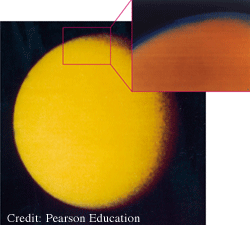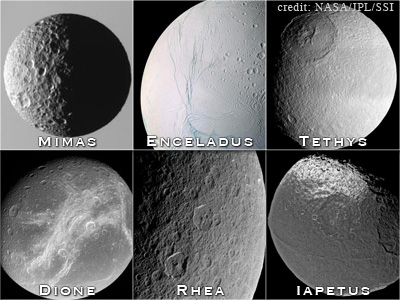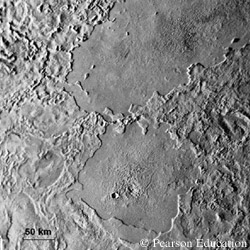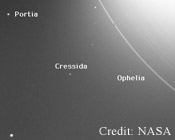
Moons of Saturn, Uranus, & NeptuneMoons of Saturn, Uranus, & Neptune
Summary: The moons of Saturn, Uranus and Neptune range in size, though most are small compared to Jupiter's moons. Titan, the largest in this group, has an atmosphere and liquid lakes.
Moons of Saturn
Moons of Uranus
Moons of Neptune
Related Lessons:
Patterns and Fingerprints
Using Spectral Data to Explore Saturn and Titan
Moons of Saturn
Titan: What lies beneath the smog?

Titan
Unlike most other moons in our solar system, Titan has a very thick atmosphere that hides its surface from view. Chemicals in the atmosphere give Titan its reddish color.
Titan's atmospheric composition:
- 90% nitrogen
- 10% mixture of argon, methane, ethane and other hydrogen compounds
Despite its distance from the Sun, Titan's surface temperature is slightly warmer than it otherwise would be due to the greenhouse effect. This is the same process that traps heat on Earth. Some scientists believe Titan's current environmental status may be similar to that of Earth's before life formed.
During the formation of the solar system, Titan formed past the frost line where temperatures in the solar nebula were cold enough for methane, ammonia and water to condense into ice. Titan is composed mostly of ices, including methane and ammonia ice. Some of this ice sublimated long ago to form an atmosphere on Titan. Over billions of years, solar ultraviolet light broke apart the ammonia molecules into nitrogen and hydrogen. The lighter hydrogen escaped from the atmosphere but the heavier nitrogen molecules remained and accumulated to give Titan its nitrogen atmosphere.
SHOW ME
THE MATH
Titan was recently visited by the Huygens probe, which landed successfully on the moon's mountainous surface after being released from the Cassini spacecraft in 2004. The Huygens probe sent back the first real images of Titan's mysterious surface, and scientists are still analyzing the data.

Saturn's Medium-Size Moons
Saturn's Medium-Size Moons
(300 — 1,500 km in diameter)
Saturn has 6 medium-size moons. In order of increasing distance from the planet, they are:
- Mimas
- Enceladus
- Tethys
- Dione
- Rhea
- Iapetus
All are heavily cratered, indicating generally ancient surfaces, but each shows evidence of past geological activity. The geological activity may seem surprising when we consider how small these moons are; all are considerably smaller than the Galilean moons. Enceladus, with its grooved terrain, is barely 500 km across (small enough to fit inside Colorado). In fact, the geological activity is probably a demonstration of the effectiveness of low temperature icy geology. Icy combinations of water, ammonia and methane can melt, deform and flow at remarkably low temperatures, producing a variety of volcanic and tectonic features.
The surface of Enceladus shows signs of intense recent geologic activity. The Cassini spacecraft passed by the moon in 2005 and returned images showing ice geysers erupting from the surface. The material spewed out from these eruptions is a primary cause of Saturn's E-ring.
MOONS OF URANUS
Uranus' medium-size moons
(300 — 1,500 km in diameter)
5 medium-size moons orbit Uranus (from innermost to outermost):
- Miranda
- Ariel
- Umbriel
- Titania
- Oberon
Uranus' medium-size moons are made of ice and rock. Like other objects that formed far from the Sun, the ice is made up of ammonia, methane and water.
These moons pose several puzzles. Ariel and Umbriel are about the same size and density, but Ariel's young features indicate volcanic and tectonic activity, while Umbriel's largely cratered, uniform surface implies a lack of geologic activity. Titania and Oberon are also very close in radius, but show different levels of geologic activity. The faults on Titania indicate internal forces while Oberon's heavily cratered, icy surface shows few signs of movement.
Voyager 2 came closest to Uranus' smallest moon, Miranda, as it passed by on its way to Neptune. The features on Miranda's surface are different from other jovian moons. With a mixture of old and new surfaces, Miranda shows relatively few craters but has a number of canyons up to 12 miles deep. Due to Miranda's odd surface features, scientists spectulate that there is an additional source of heat, such as tidal heating. The cliff walls seen in the inset are higher than those of the Grand Canyon on Earth.
Uranus' small moons
Uranus' smallest moons are its innermost satellites. Portia heads a group of 8 inner satellites. The Portia Group consists of Bianca, Cressida, Desdemona, Juliet, Rosalind, Cupid, Belinda and Perdita. The Portian orbit is slowly decaying due to tidal deceleration and may one day either break apart to form a planetary ring or could potentially collide with Uranus. Orbits of the other satellites in the Portia Group have a similar fate.
MOONS OF NEPTUNE
Neptune has 13 known moons, though most are small and orbit closer to Neptune than its rings. Triton is Neptune's only large moon with a diameter of 2,704 km, and Proteus and Nereid are Neptune's second and third largest moons, respectively.
Triton: The backward moon of Neptune
Voyager 2 discovered many of Neptune's moons in 1989, and took pictures revealing many previously unknown properties of Triton. Triton's icy, spherical surface reflects so much of the sunlight it receives that it is the coldest world in the solar system.
Triton is the only moon in the solar system with a retrograde orbit. This, along with Triton's high inclination relative to Neptune's equator, suggests that Triton may have been captured from interplanetary space.

The surface of Triton
Photos of Triton show a strange surface shaped by more than just impact cratering, although its many undisturbed craters suggest that major geologic activity has subsided. Regions on Titan's surface show evidence of past volcanic and tectonic activity. The internal heat source for Triton's geologic activity is not known, but it may involve tidal heating.
The sublimation of surface ices creates a thin, hazy atmosphere on Triton made mostly of Nitrogen. The atmosphere creates wind streaks on the surface, and unknown processes pump unusual plumes of gas and particles into the atmosphere.




